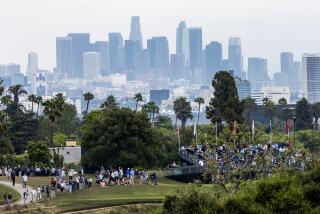Rideshare Week Aims to Steer Commuters Toward New Habits
Ever considered trading in the long, traffic-jammed daily trek to work for a speedier cruise down a wide-open carpool lane, spiced up by lively conversation with colleagues?
This could be the week to try it.
Beginning Monday, Southern California Rideshare is sponsoring California Rideshare Week â97. From Monday through Friday, commuters are encouraged to carpool or use an alternative form of transportation to the traditional one-car, one-person method of going to work.
Though Southern Californiansâ participation in carpools has remained virtually unchanged in the last 17 years, the region still leads all metropolitan areas in the country in the number of carpools. Thatâs the good news. The bad news is the reason: Carpooling has declined around the country.
This yearâs Rideshare Week is an effort to maintain--if not improve--participation in the Los Angeles area, said Cheryl Collier, the organizationâs manager of rideshare services.
âThe purpose is to get people thinking about other forms of transportation,â she said. âA good number of folks who actually try it like it, and continue with it.â
Southern California Rideshare formed as a nonprofit organization in 1974 in response to the gas crunch, according to the organizationâs leaders.
In 1995, it was absorbed by the Southern California Assn. of Governments, which represents cities in six counties--Los Angeles, Orange, Ventura, Imperial, Riverside and San Bernardino.
Today, through year-round efforts, Rideshare reaches about 4,000 employers and 500,000 people in those areas, providing them with information on everything from lists of people looking for rideshare partners to how to set up a carpool. The organization can be reached at 800 COMMUTE.
The organization estimates that there are about 6.7 million daily commuters within the region it serves. About 79% of those commuters drive to work alone three or more times a week, while 21% use some form of ride sharing--from bus to train to van pools.
*
Though local statistics have remained unchanged for years, national figures indicate that ride sharing has taken the back seat.
There were 19 million carpools in the country in 1980. But by 1990, the number had dropped to 15.4 million--or a drop from a 20% share of all commuters to a 13.4% share, said Kenneth Green, director of environmental studies for Los Angeles-based Reason Public Policy Institute.
During the same time, the national percentage of drivers commuting alone increased from 64% to 73%.
Other studies since 1990 have indicated that carpools are still declining, but at a slower rate, Green said.
âThe last thing I want to do is give the impression that carpooling is a bad thing,â said Joseph Schofer, professor of civil engineering and transportation at Northwestern University. âBut itâs hard to ask people to change their behavior. The truth is that carpooling is less convenient.â
Schofer said carpooling declines have been more slight in the West--especially in California--for various reasons.
Among them, there is a heavier emphasis on environmental issues in the West, Schofer said. For example, lawmakers in Western states have enacted transportation legislation conducive to carpooling, such as Southern Californiaâs extensive and growing carpool lanes. And leading the way is Los Angeles.
*
âIn one way, Los Angeles is ahead of the nation in carpooling simply because the country as a whole has not reached a consensus that air pollution is a problem,â Schofer said. âYouâve been at it a long time.â
Eliminating some air pollution is one motivation behind the annual rideshare events, Collier said.
Searching for commuters who will take the plunge into ride sharing on this 12th annual event, the organization distributed roughly 1 million pledge cards--about the number sent out every year--around Southern California.
The organization performed a study in 1991 to evaluate the success of that yearâs event, Collier said.
The results indicated that about 11% of the cards distributed were returned. Random sample polling some time after the event revealed that about 49% of the participants continued using other forms of transportation aside from driving alone.
âOf course we would like to see more [ride sharing],â Collier said about the present figures. But because âthe area already has a reputation for being such a car-loving region, itâs very much a positive to have the numbers that we have.â
More to Read
Sign up for Essential California
The most important California stories and recommendations in your inbox every morning.
You may occasionally receive promotional content from the Los Angeles Times.










